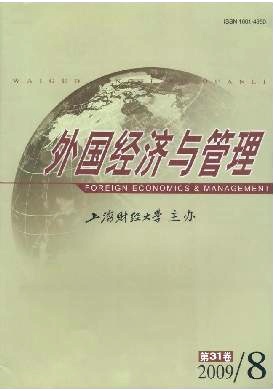组织间关系的社会逻辑观评介
外国经济与管理 2009 年 第 31 卷第 08 期, 页码: - 18
摘要
参考文献
摘要
20世纪90年代末,社会逻辑观(又称关系观)因其独特的研究视角、关注焦点及实践应用而成为国内外组织间关系研究的热点。本文从社会逻辑观的理论渊源、基本思想以及它对组织间关系研究的意义等方面对相关研究成果进行了梳理和述评,并对未来研究进行了展望。
[1]Jeffrey H Dyer,and Harbir Singh.The relational view:Cooperative strategy and sources of interorganizational competitive advantage[J].Academy of Management Journal,1998,23(4):660-679.
[2]R Duane Ireland,Michael A Hitt,and Deepa Vaidyanath.Alliance management as a source of competitive advantage[J].Journal ofManagement,2002,28(3):413-446.
[3]罗珉.组织间关系理论最新研究视角探析[J].外国经济与管理,2007,29(1):25-32.
[4]Akira Takeishi.Bridging inter-and intra-firm boundaries:Management of supplier involvement in automobile product development[J].Strategic Management Journal,2001,22(5):403-433.
[5]Luiz F Mesquita,and Thomas HBrush.Comparing the resource-based and relational views:Knowledge transfer and spillover in ver-tical alliances[J].Strategic Management Journal,2008,29(9):913-941.
[6]Lourdes Urriolagoitia,and Marcel Planellas.Sponsorship relationships as strategic alliances:Alife cycle model approach[J].BusinessHorizons,2007,50(2):157-166.
[7]Jeffrey H Dyer,Harbir Singh and Prashant Kale.Splitting the pie:Rent distribution in alliances and networks[J].Managerial andDecision Economics,2008,29(2/3):137-148.
[8]Jeffrey H Dyer,and Nile W Hatch.Relational-specific capabilities and barriers to knowledge transfer:Creating advantage throughnetwork relationships[J].Strategic Management Journal,2006,27(5):701-719.
[9]Peter MBlau.Exchange and power in social life[M].New York:Wiley,1964.
[10]P Fraser Johnson,Robert D Klassen,Michiel R Leenders,and Amrou Awaysheh.Utilizing e-business technologies in supplychains:The i mpact of firmcharacteristics and teams[J].Journal of Operations Management,2007,25(6):1 255-1 274.
[11]罗珉,徐宏玲.组织间关系:价值界面与关系租金的获取[J].中国工业经济,2007,(1):68-77.
[12]Augustine ALado,Rajiv R Dant,and Amanuel G Tekleab.Trust-opportunismparadox,relationalism,and performanceininterfirmrelationships:Evidence fromthe retail industry[J].Strategic Management Journal,2007,29(4):401-423.
[13]Mark H Hansen,Robert E Hoskisson,and Jay B Barney.Competitive advantagein alliance governance:Resolving the opportunismmini mization-gain maxi mization paradox[J].Managerial and Decision Economics,2008,29(2/3):191-208.
[14]Raymond Van Wijk,Justin J P Jansen,and Marjorie A Lyles.Inter-and intra-organizational knowledge transfer:A meta-analyticreviewand assessment of its antecedents and consequences[J].Journal of Management Studies,2008,45(4):830-853.
[15]Manuel Becerra,Randi Lunnan,and Lars Huemer.Trustworthiness,risk,and the transfer of tacit and explicit knowledge betweenalliance partners[J].Journal of Management Studies,2008,45(4):691-713.
[16]Prashant Kale,Harbir Singh,and Howard Perl mutter.Learning and protection of proprietary assets in strategic alliances:Buildingrelational capital[J].Strategic Management Journal,2000,21(3):217-237.
[17]Bruce Kogut,and Udo Zander.Knowledge of the firm,combinative capabilities,and the replication of technology[J].OrganizationScience,1992,3(3):383-397.
[2]R Duane Ireland,Michael A Hitt,and Deepa Vaidyanath.Alliance management as a source of competitive advantage[J].Journal ofManagement,2002,28(3):413-446.
[3]罗珉.组织间关系理论最新研究视角探析[J].外国经济与管理,2007,29(1):25-32.
[4]Akira Takeishi.Bridging inter-and intra-firm boundaries:Management of supplier involvement in automobile product development[J].Strategic Management Journal,2001,22(5):403-433.
[5]Luiz F Mesquita,and Thomas HBrush.Comparing the resource-based and relational views:Knowledge transfer and spillover in ver-tical alliances[J].Strategic Management Journal,2008,29(9):913-941.
[6]Lourdes Urriolagoitia,and Marcel Planellas.Sponsorship relationships as strategic alliances:Alife cycle model approach[J].BusinessHorizons,2007,50(2):157-166.
[7]Jeffrey H Dyer,Harbir Singh and Prashant Kale.Splitting the pie:Rent distribution in alliances and networks[J].Managerial andDecision Economics,2008,29(2/3):137-148.
[8]Jeffrey H Dyer,and Nile W Hatch.Relational-specific capabilities and barriers to knowledge transfer:Creating advantage throughnetwork relationships[J].Strategic Management Journal,2006,27(5):701-719.
[9]Peter MBlau.Exchange and power in social life[M].New York:Wiley,1964.
[10]P Fraser Johnson,Robert D Klassen,Michiel R Leenders,and Amrou Awaysheh.Utilizing e-business technologies in supplychains:The i mpact of firmcharacteristics and teams[J].Journal of Operations Management,2007,25(6):1 255-1 274.
[11]罗珉,徐宏玲.组织间关系:价值界面与关系租金的获取[J].中国工业经济,2007,(1):68-77.
[12]Augustine ALado,Rajiv R Dant,and Amanuel G Tekleab.Trust-opportunismparadox,relationalism,and performanceininterfirmrelationships:Evidence fromthe retail industry[J].Strategic Management Journal,2007,29(4):401-423.
[13]Mark H Hansen,Robert E Hoskisson,and Jay B Barney.Competitive advantagein alliance governance:Resolving the opportunismmini mization-gain maxi mization paradox[J].Managerial and Decision Economics,2008,29(2/3):191-208.
[14]Raymond Van Wijk,Justin J P Jansen,and Marjorie A Lyles.Inter-and intra-organizational knowledge transfer:A meta-analyticreviewand assessment of its antecedents and consequences[J].Journal of Management Studies,2008,45(4):830-853.
[15]Manuel Becerra,Randi Lunnan,and Lars Huemer.Trustworthiness,risk,and the transfer of tacit and explicit knowledge betweenalliance partners[J].Journal of Management Studies,2008,45(4):691-713.
[16]Prashant Kale,Harbir Singh,and Howard Perl mutter.Learning and protection of proprietary assets in strategic alliances:Buildingrelational capital[J].Strategic Management Journal,2000,21(3):217-237.
[17]Bruce Kogut,and Udo Zander.Knowledge of the firm,combinative capabilities,and the replication of technology[J].OrganizationScience,1992,3(3):383-397.
引用本文
任丽丽. 组织间关系的社会逻辑观评介[J]. 外国经济与管理, 2009, 31(8): 0–18.
导出参考文献,格式为:
上一篇:泰罗主义、泰罗文本与心理革命辨析





 6538
6538  665
665

